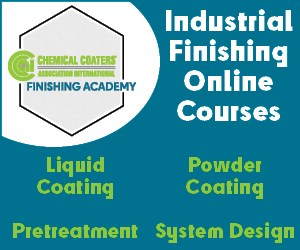Remove More Nox
Do you have any ideas to reduce the yellow/brown color of air emissions from our nitric acid-based aluminum bright dip process?
Q: Do you have any ideas to reduce the yellow/brown color of air emissions from our nitric acid-based aluminum bright dip process? We are currently using two wet scrubbers in series with a caustic recirculating liquor. Even though our emissions are within our permit limits, we would like to reduce this color as much as possible due to periodic complaints by neighbors.
A: In various metal finishing operations where nitric acid is utilized, the emitted plume of nitrous oxides (nitrogen oxide ,NO, and nitrogen dioxide, NO2 , or NOx ) from baths and dips is observed as a characteristic yellow-brown vapor. This regulated pollutant has typically been, and continues to be, controlled by contacting the gas stream with aqueous caustic (NaOH) in a single or series scrubber system. This approach has been simple and cost effective, yet presents some problems.
One problem is the varying solubility NO and NO2 . NO2 is very soluble and reactive in alkali solutions; however NO is not very soluble or reactive in the same conditions, often resulting in visible emissions from the scrubber. Therefore, the likely source of your remaining color is NO. Further complicating this is the formation of nitrates (NO3) and nitrites (NO2) in the alkali solution by the following chemical reactions:
NO + NO2 —› N2 O3
N2O3 + 2 NaOH —›2 NaNO2 + H2O
2 NO2 + 2 NaOH —› NaNO2 + NaNO3 + H2O
As you can see from these chemical reactions, lots of sodium nitrite (NaNO2) is generated, which salts up components and results in frequent scrubber cleanings.
The main method to reduce NOx emissions beyond that of the caustic systems has been to replace or augment the caustic in the scrubber liquor with other compounds, such as sodium hypochlorite, sodium hydrosulfide, and hydrogen peroxide.
Sodium hypochlorite is relatively cheap, easy to handle and oxidizes the NO to NO2, leaving sodium chloride in solution. It is typically used in the first stage in conjunction with a second stage caustic scrubber. Since this also produces a salt (NaCl), frequent blow-down and bleed-off is required. It adds little to the water effluent steam over the caustic system. This is represented by the following reaction:
First stage: NO + NaClO —› NaCl + NO2
Second stage: 2 NO2 + 2 NaOH ? NaNO2 + NaNO3 + H2O
Sodium hydrosulfide is also cheap and efficient in aqueous scrubbers. The drawback to this method is the hazardous nature of NaHS, resulting in increased regulatory needs of reporting, recordkeeping, and the costs of neutralizing the spent liquor before disposal due to its high alkalinity. This is represented by the following reaction:
NaHS + 4 NO —› NaHSO4 + 2 N2
NaHS + 2 NO2 —› NaHSO4 + N2
Also, the neutralization reaction produces hydrogen sulfide and mercaptans, causing a “rotten egg” odor problem.
Hydrogen peroxide is gaining favor, having not been considered at first due to its perception of high cost. However, when maintenance, salt removal, and disposal costs of the other additives are added in, this compound is very competitive. Hydrogen peroxide is as effective as caustic, and in some cases better, since its efficiency is higher at increased concentrations of NO2. Hydrogren peroxide’s reaction with NOx is represented here by:
2 NO + 3 H2O2 —› 2 HNO3 + 2 H2O
2 NO2 + H2O2 —› 2 HNO3
Hydrogen peroxide has a few other advantages: One is the formation of nitric acid in the scrubber, which can be recycled back to the process in some applications. Two, hydrogen peroxide produces no salts, eliminating much of the maintenance, downtime and disposal costs associated with caustic. Three, H2O2 is environmentally compatible, and presents minimal handling requirements and wastewater issues at the commonly used 3% concentration. Additionally, H2O2 systems can be retrofitted at minimal expense.
Column design for these systems generally uses single-stage, low-column-velocity (<100 fpm), deep-bed depths (15 to 20 ft), and high water rates (30 to 40 gpm/ft2 ). Materials of construction will not change for the use of hydrogen peroxide over caustic because the driving factor in corrosion is the nitric acid (HNO3). A two-column design (if the first column has enough residence time) could be used to produce from the first column, using H2O2, a concentrated (30–40%) HNO3 effluent to be recycled back into process or off-site, and the second column could be used to further reduce any nitric acid vapors or mists using your existing caustic liquor.
Any of these additions to or replacements of caustic will result in removal of NO which, even at permitted limits, appears to be causing the visible plume.
Related Content
Ultrafiltration Membranes, Filter Elements for Improved Industrial Water Reuse
Ultrafiltration membranes help with water reuse in a variety of applications.
Read MoreHubbard-Hall Acquires BioConversion Technology
The acquisition adds experience and biologics to the AquaPure product line.
Read MoreNASF/AESF Foundation Research Project #122: Electrochemical Approaches to Treatment of PFAS in Plating Wastewater - 10th Quarterly Report
The NASF-AESF Foundation Research Board selected a project addressing the problem of PFAS and related chemicals in plating wastewater streams. This report covers the 10th quarter of work (April-June 2023). Here, we examine the effect of surface fluorination of Ti4O7 anodes on PFAS degradation performance in terms of energy performance as well as formation of chlorate and perchlorate when chloride is present in the solution. The full paper on this work can be accessed and printed at short.pfonline.com/NASF24Feb2.
Read MoreNASF/AESF Foundation Research Project #120: Electrochemical Destruction of Perfluorooctanesulfonate in Electroplating Wastewaters - April 2022-March 2023
This NASF-AESF Foundation research project report covers project work from April 2022 to March 2023 at the University of Illinois at Chicago. The overall objective of this work is to utilize a cost-effective reactive electrochemical membrane (REM) for the removal of PFAS from synthetic electroplating wastewater. Initial results for the oxidation of PFOA with three different catalysts are discussed.
Read MoreRead Next
Education Bringing Cleaning to Machining
Debuting new speakers and cleaning technology content during this half-day workshop co-located with IMTS 2024.
Read MoreEpisode 45: An Interview with Chandler Mancuso, MacDermid Envio Solutions
Chandler Mancuso, technical director with MacDermid Envio discusses updating your wastewater treatment system and implementing materials recycling solutions to increase efficiencies, control costs and reduce environmental impact.
Read MoreA ‘Clean’ Agenda Offers Unique Presentations in Chicago
The 2024 Parts Cleaning Conference, co-located with the International Manufacturing Technology Show, includes presentations by several speakers who are new to the conference and topics that have not been covered in past editions of this event.
Read More










.jpg;maxWidth=300;quality=90)












